Authors
Beyond good and evil?
Issue 2/1987 | Archives online, Authors, Interviews
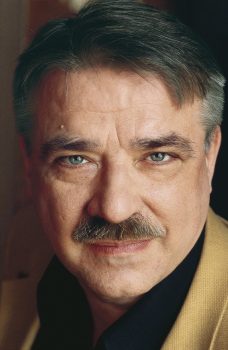
Esa Sariola. Kuva Irmeli Jung
Markku Huotari interviews Esa Sariola
A stylish restaurant in the Stock Exchange building in Helsinki. Esa Sariola and I order a businessmen’s lunch. We talk about hard-nosed success stories. About technocracy, casino economics.
About profit.
A steely-eyed businessman enters the room from the stock exchange and sees us two soft-talkers, even if we look like men, wasting time. The ruthless gambler bolts down his lunch and disappears to the upper floor again, where he is making money.
We remain.
We’re just talking.
And there’s no money accruing in our wallets.
All the same we have a grip on that investor. Esa Sariola has already laid siege to people like him in three books: Väärinkäsityksiä (‘Misconceptions’, 1983), a collection of short stories, and two novels: Rakas ystävä (‘Dear friend’, 1985) and Kuolemaani saakka (‘Until my dying day’, 1986). More…
Soulscapes
Issue 2/1987 | Archives online, Authors, Reviews
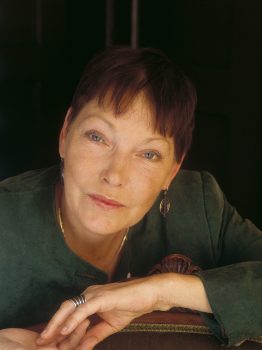
Raija Siekkinen. Photo: Irmeli Jung
When the first collection of short stories by Raija Siekkinen (born 1953), entitled Talven tulo (‘The coming of winter’, 1978) appeared, the critics were unanimous on one point: here was a mature writer with an original, individual voice. For her second collection, Tuomitut (‘The condemned’, 1982), Raija Siekkinen received the coveted Kalevi Jäntti Prize. Since then she has remained faithful to the short story. And since the publication of her fourth collection, Pieni valhe (‘A small lie’), the reader has been able to trace a development in which she has polished and tightened her narrative and brought to it more and more poetic and symbolic elements.
The main character in Raija Siekkinen’s short stories is generally a woman, not old but not very young either, often alone, sometimes broken by illness. Death is a recurring theme with Siekkinen; illness withers her women, her men die sometimes by their own hand. Siekkinen writes seldom about children; when she does so, it is from a child’s point of view. This perspective results in a critique of the narrow and restricted world view of adults. But always sensitively, never pointing the finger. More…
A poet of the fresh air
Issue 2/1987 | Archives online, Authors, Interviews
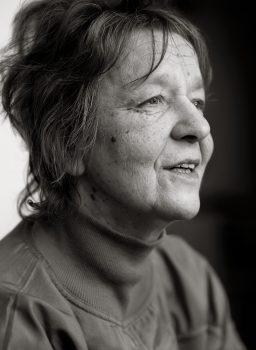
Sirkka Turkka. Photo: Pertti Nisonen
Sirkka Turkka is interviewed by Markku Huotari
Snowflakes are already covering the forest, and an angry wind is blowing off Lake Lohjanjärvi. It is autumn, and in the courtyard, at the roots of a stunted rowan, is a lounge chair, its paint already peeling.
‘I’ve left the chair there because my mother used to sit in it and knit.’
I start at Sirkka Turkka’s comment. In my mind is her last-but-one volume of poetry, Vaikka on kesä (‘Although it’s summer’, 1983); its poems sound a contemporary lament, occasioned by her mother’s death.
‘There’s nothing made-up in my poetry,’ says Sirkka Turkka.
Landscape, nature, the circular path of life – all of these have left their wounds in Sirkka Turkka’s poetry. But as she writes in Tule takaisin, pikku Sheba (‘Come back, little Sheba’, 1986), winner of the Finlandia Prize 1987, ‘from the wounds life grows’. More…
A sense of order
Issue 2/1987 | Archives online, Authors, Reviews
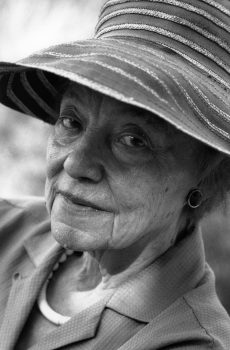
Solveig von Schoultz. Photo: Charlotta Boucht
That Solveig von Schoultz occupies the position of ‘grand old lady’ of Finland-Swedish poetry is beyond question; yet it is an epithet that fits her badly. It all too easily suggests the image of a stern and queenly poetess, an Edith Sitwell, Marianne Moore or Gabriela Mistral. The poetesses of Scandinavia are, by and large, less solemn – more gentle and down-to-earth, even when they grow older and wiser and ascend some of Parnassus’s more elevated thrones.
Solveig von Schoultz has, of course, had a long journey to the top. She has behind her twelve collections of poetry, at least fifteen volumes of prose, and an even greater number of plays for radio, television and theatre, spanning a good fifty years’ acitivity as a writer.
In this long artistic career there is both continuity and development. It might be said that the continuity is represented by the fact that from the very beginning she has preferred to describe women – their daily lives, their loves, thoughts, impulses, relationships. But since so much in the world of women and in women’s thinking has changed during the decades since her literary debut in the 1930s, both her themes and her outlook have necessarily altered, too. Among other things, she has had many of her early, then only half-developed ideas taken up by a later generation, and has thereby had them given back to her renewed. As a feminist she has always been one of the least militant, and for a short time some of her younger co-sisters were uncertain about the strength of her commitment to the Cause. More…
Portraits of change
Issue 1/1987 | Archives online, Authors, Interviews
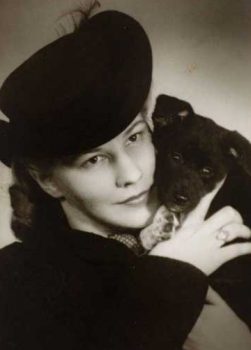
Eeva Joenpelto. Photo: Tyyne Havia / SKS Archives
Erkka Lehtola interviews Eeva Joenpelto
You can see Eeva Joenpelto’s house from a long way off: a substantial red-painted building in the southern Finnish village of Sammatti. It is the kind of house rich Finnish farmers lived in in days gone by.
The farmyard is big; behind the hedge loom the neighbouring fields and the blue mushroom woods of autumn. In the flower beds are roses and ornamental plants; the red farmhouse breathes the old Finnish countryside tradition.
But there has been no farming in the red house’s fields and meadows for a long time now. Eeva Joenpelto moved from the capital to these peaceful country surroundings just a few years ago.
All the same, the red house, the well-kept yard and forest and cornfields nearby have an important significance: for in many of her novels Eeva Joenpelto, the writer who has moved to the country, describes a huge shift in Finnish society. Many of her novels show the disintegration of the old Finnish agrarian society, and the industrial Finland, that creation of supply and demand, taking its place. More…
Too much or too little love
Issue 1/1987 | Archives online, Authors, Reviews
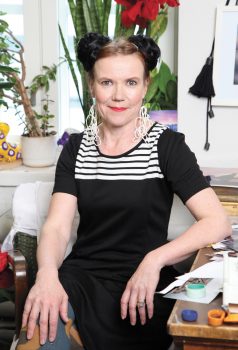
Rosa Liksom. Photo: Pekka Mustonen.
On the October day last year on which Rosa Liksom‘s second collection of short stories, Unohdettu vartti (‘The forgotten quarter’), was published, she also opened an art exhibition of her own work. The occasion took the form of a kind of cross between performance art and a practical joke. Young women dressed in Finnish military uniforms carried out body searches on every newcomer, changed the guard and drilled, while crackers exploded in the gallery. Many people were of the opinion that it was all no more than a silly joke. Even the art critics were not enthusiastic: they felt that Rosa Liksom’s felt pen work was derivative of a certain Danish artist who himself had copied the cartoon-like stick-men of the so-called Chicago school. But all the same, there emerged from the pictures a funny story about the artist’s adventures among the underground youth of Russia from Leningrad to Vladivostock.
Only her closest friends knew which of the soldiers in the gallery was Rosa Liksom, which her clones. Rosa Liksom is a pseudonym, and her little game of hide and seek has already lasted a couple of years. We know of her that she was born in Lapland, studied anthropology, has travelled in both East and West and lived for a long time in Copenhagen. Her writing was published for the first time in an anthology of the work of young authors, Kalenteri 84 (‘Calendar 84’, 1984). Her first work, the short story collection Yhden yön pysäkki (‘One-night stand’) was published in 1985 and achieved considerable success. More…
Science facts, science fiction
Issue 1/1987 | Archives online, Articles, Authors, Non-fiction
Science fiction has never been one of the great success stories of the Finnish book business. But interest in the genre is nevertheless undoubtedly greater than the sales figures give us to understand. And there are other pointers: at present, for instance, five magazines entirely devoted to the subject are published in Finland.
In 1986 the astronomical society Ursa organised a science fiction writing competition, in connection with which a preliminary bibliography of Finnish science fiction was put together.
That bibliography revealed some surprising science fiction enthusiasts: some of the best-known names in Finnish literature, such as Mika Waltari and Toivo Pekkanen, turned out to have given their imaginations a holiday at some point in their careers and turned their hands to a couple of colourful pieces of science fiction. More…
The aphorism reborn
Issue 4/1986 | Archives online, Authors, Essays, Non-fiction
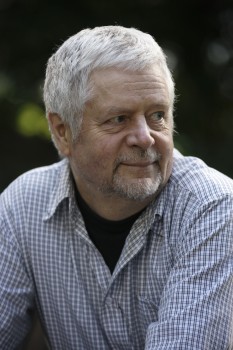
Markku Envall. Photo: Pertti Nisonen
With the passage of time a literary genre may continue, change or disappear. During the 1960s it was widely believed that the Finnish aphorism was dead. Modernism, which had consolidated its victory during that decade, was not favourable to the genre, and not one of the central figures of the post-war generation had touched the genre. Nevertheless, phoenix-like, the aphorism rose from the ashes, and by the 1970s it was strongly in evidence again, thanks, in the main, to just four writers, Mirkka Rekola, Paavo Haavikko, Samuli Paronen and Erno Paasilinna.
The renaissance took place between 1969 and 1972; in 1969 Mirkka Rekola’s first book of aphorisms was published, followed in 1972 by Paavo Haavikko’s. Rekola now has three books of aphorisms to her name, Haavikko four. The other two major aphorists have published one volume each. There have been a few other collections of aphorisms have appeared, but their authors are ‘merely’ aphorists, while these four are recognised as major authors in other fields too.
What was new in the renaissance of the aphorism? The question is easiest to answer in respect of the three men; Rekola is in many ways an exception. There were two major new features, one concerning meaning, the other form. The subject matter of the new writers was broader than the wisdom and teachings about life encompassed by the traditional aphorism. Their main subjects were nothing if not ambitious; the nature of the world, the progress of history, the structure of society. More…
Youth revisited
Issue 4/1986 | Archives online, Authors, Extracts, Non-fiction
Extracts from a diary. Introduction by Kai Laitinen
10.4.46
I thought I might weep today, now that it’s evening and I’m alone. But after all, I’m not weary enough. Instead I’ll read some Rilke: The Book of Hours, Stunden-Buch. Whose pages I turned at seventeen and tried to see. Now it’s all simply backtracking. Rilke’s the weeping I was expecting. That soft bitter swirling I sink into without troubling myself whether it’s good for me or bad.
I’ve been three days without writing a poem and it’s beginning to nag me already. Earlier, I was three months and it bothered me less. But I shan’t weep. I’ll read Rilke. I’m that young monk who believes he’s capable of being some day so afraid his arteries will burst. More…
A poet’s perspective
Issue 4/1986 | Archives online, Authors, Reviews
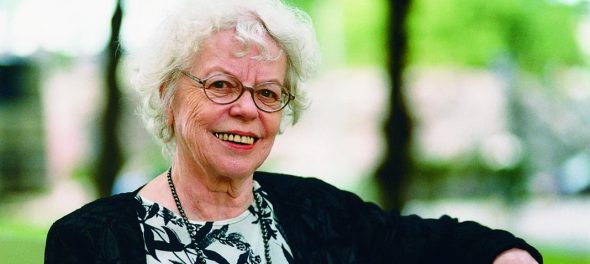
Aila Meriluoto. Photo: Pertti Nisonen
When Aila Meriluoto burst on to the world of Finnish poetry 40 years ago in the autumn of 1946 she was at once hailed as a youthful prodigy. Praised lavishly by the leading critics, the 22-year-old poet’s first collection, Lasimaalaus, sold in phenomenal numbers: in a couple of years it went through eight editions, or 25,000 copies, which in Finland is still a record figure. Today total sales are well over 30,000.
Two poems attracted particular attention. One was Kivinen Jumala (‘God of stone’), a poem of defiance unleashed by the experience of wartime bombing, in which God is portrayed as having changed into a stone statue, and people as having hardened correspondingly. It was the first reaction of the younger generation to the war – abusive, strong and inevitable, the proclamation of the death of the kind, just God.
The other central poem of the collection was Lasimaalaus (‘Stained glass’) from which the collection took its name: a taut post-symbolist vision and a dazzling synthesis of the oneness of the world. Baudelaire, master of correspondances, might well have been satisfied with it. More…
Concrete dreams
Issue 3/1986 | Archives online, Authors, Reviews
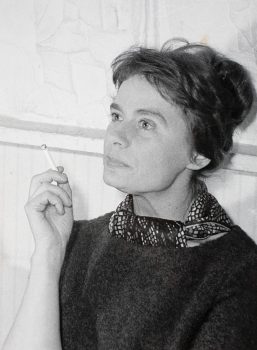
Marja-Liisa Vartio. Photo: SKS archives
Pirkko Alhoniemi on Marja-Liisa Vartio’s works
Although it is now 20 years since the death of Marja-Liisa Vartio (1924-1966), her writing remains as vivid as ever. Her books are regarded as classics of modern Finnish prose, and they constantly attract new readers, as the demands for reprints testify. Vartio’s style has not lost its freshness, nor her social vision its edge, even in the teeth of the aggressive feminism of the 1980s.
It is a little difficult to gauge the secret of her continued popularity. Although the main character of her novels is always a woman, Vartio cannot really be seen as a champion of the feminine point of view. Most essential and at the same time paradoxical in her work is perhaps the fact that, from a purely Finnish starting point, she is able to give valuable insights into the general change in world view that followed the Second World War. More…
Jouko Turkka’s factory of ideas
Issue 3/1986 | Archives online, Authors, Reviews
Jouko Turkka (born 1942) is a man of theatre by profession, not a writer. But according to him, all theatre people want to write: dramatic art is very transient, somehow one would like to immortalise one’s thoughts. ‘I want to destroy this virus’, he says in his book Aiheita (‘Themes’, 1983). ‘I don’t want future generations to waste their lives on this. – I have set down these “themes” of mine, in as simple a form as possible, just to show that I too have had a go at it. – Now I have got them off my chest, I need never write anything again.’
The following year Turkka published a novel, Kantelu oikeuskanslerille (‘A case for the Chancellor of Justice’), this year his play Hypnoosi (‘Hypnosis’) was performed at the Helsinki City Theatre; and this year, too, his play Lihaa ja rakkautta (‘Meat and love’) was performed in Gothenburg, Sweden. Turkka – theatre director, producer, former rector of the Theatre Academy (1983-85), where he is currently professor of theatre directing – evidently could not shake off the writing bug as easily as he had thought. More…
On Martti Joenpolvi
Issue 2/1986 | Archives online, Authors
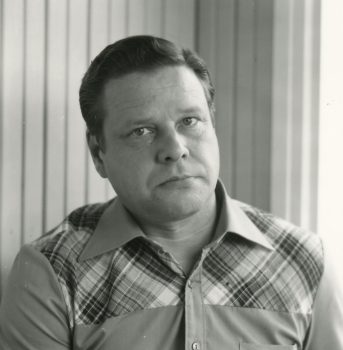
Martti Joenpolvi. Photo: SKS archives
Martti Joenpolvi made his literary debut in 1959 at the age of 23, a young man who had been evacuated twice during the course of the Second World War and had eventually settled in an industrial town in the Häme region of southern Finland.
His first novel, Kevään kuusi päivää (‘Six days in spring’), was in the best tradition of the so-called working-class novel. The book described a young worker’s inner struggles and his quest for life from much the same standpoint as the classic novels of Väinö Linna, Lauri Viita and Toivo Pekkanen.
About ten years later Martti Joenpolvi began to write short stories, which were to prove an important complement to his as a novelist. At the same time he his narrative technique: his use of language become clearer and more.polished, and his unaffected style gained power through the use of symbolism and a dryish wit. At the same time his characters began to move in more middle-class surroundings; these people now had a position in society from which to view the world. More…
Strange and familiar
Issue 1/1986 | Archives online, Authors
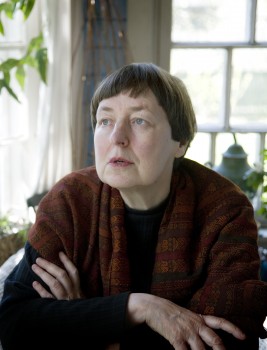
Leena Krohn. Photo: Katri Lassila
Tainaron is the name of the rocky headland from which the road to Hades starts. Leena Krohn has borrowed her book’s title from Greek mythology: the city of Tainaron lies in the volcanic region, on the banks of Okeanos. On the title page of Tainaron is this epigraph: ‘You are not in a place; the place is in you.’ The book’s subtitle is ‘Letters from another town’. The narrator of the book writes letters to her friend back in our world.
The inhabitants of Tainaron are different from us – they have the bodies of insects. In the street the letter-writer encounters a character whose ‘antennae wave above his muzzle-like face’, the café waiter’s mouth ‘protrudes from his face like that of a dragonfly grub’ and when her friend and mentor, Longhorn Beetle, smiles, it is ‘a slow sideways extension of the jaws to the two sides of his head’. Among the dedicatees of Krohn’s book is the well-known entomologist Jean Henri Fabre. More…
A policeman’s crimes
Issue 4/1985 | Archives online, Authors
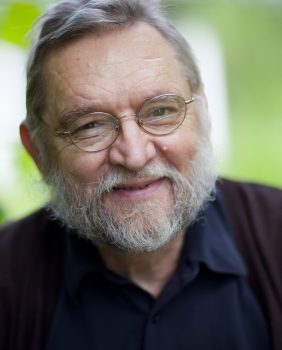
Matti Yrjänä Joensuu. Photo: Jouni Harala 2010
The Finnish section of the major Nordic Crime Novel Competition in 1976 was won by a newcomer, Matti Yrjänä Joensuu, with his Väkivallan virkamies (‘Civil servant in violence’). A realistic crime and police novel in the style of the Swedish writers Sjöwall and Wahlöö, the book represented something completely new in Finland. In the previous competition, held in 1939 as Europe hovered on the brink of war, the winner of the Finnish section was Mika Waltari’s Kuka murhasi Rouva Skrofin (‘Who killed Mrs Skrof?’); the novel is now regarded as one of the classics of Nordic detective fiction. But Waltari was, of course, a literary polymath; his Sinuhe, egyptiläinen (1945; English translation The Egyptian) is among the internationally best-known Finnish novels.
The detective novel and thriller tradition in Finland is both short and slight, and apart from Waltari’s book and its two sequels, many of its representatives – even those that have been most widely acclaimed and read at the time – are of little worth by any objective standards. Joensuu, therefore, has no living tradition to follow, and in interviews he has said that at the start of his career he was not familiar with the two Swedish writers to whom his work is most readily likened, Sjöwall and Wahlöö. This is not difficult to believe; in terms of both politics and social criticism Joensuu’s first novel, in particular, is much tamer than the Swedish writers’ – what all three writers have in common is the gravity with which they approach crime and the individuals who engage in it, and their realistic description of the work of the police. More…
-
Currently browsing
Interviews with Finnish authors and introductions to their work
-
RSS feed
Subscribe to RSS feed for Authors
-
List of authors and contributors
- Abu-Hanna, Umayya
- Ågren, Gösta
- Aho, Hannu
- Aho, Juhani
- Aho, Claire & Westö, Kjell
- Ahola, Suvi
- Ahti, Risto
- Ahtola-Moorhouse, Leena
- Ahvenjärvi, Juhani
- Ala-Harja, Riikka
- Alftan, Maija
- Alhoniemi, Pirkko
- Anderson, John
- Andersson, Claes
- Andersson, Jan-Erik
- Andtbacka, Ralf
- Anhava, Tuomas
- Antas, Maria
- Apunen, Matti
- Aro, Tuuve
- Aronpuro, Kari
- Autio, Milla
- Bargum, Johan
- Bargum, Marianne
- Barrett, David
- Binham, Philip
- Björling, Gunnar
- Blau DuPlessis, Rachel
- Bolgár, Mirja
- Boucht, Birgitta
- Bremer, Caj
- Bremer, Stefan
- Brotherus, Elina & Ala-Harja, Riikka
- Byggmästar, Eva-Stina
- Canth, Minna
- Carlson, Kristina
- Carpelan, Bo
- Chan, Stephen
- Chorell, Walentin
- Diktonius, Elmer
- Ekman, Michel
- Ekroos, Anna-Leena
- Enckell, Agneta
- Enckell, Martin
- Enqvist, Kari
- Envall, Markku
- Eskola, Kanerva
- Fagerholm, Monika
- Flint, Austin
- Forsblom, Harry
- Forsblom, Sabine
- Forsström, Tua
- Gothóni, Maris
- Granö, Veli
- Gripenberg, Catharina
- Gröndahl, Satu
- Grünthal, Satu
- Haanpää, Pentti
- Haapala, Vesa
- Haasjoki, Pauliina
- Haatanen, Kalle
- Haavikko, Paavo
- Hämäläinen, Helvi
- Hämäläinen, Timo
- Hännikäinen, Timo
- Hänninen, Anne
- Hannula, Risto
- Harju, Timo
- Härkönen, Leena
- Harmaja, Saima
- Hassinen, Pirjo
- Havukainen, Aino & Toivonen, Sami
- Hawkins, Hildi
- Heikkilä-Halttunen, Päivi
- Heikkonen, Olli
- Heinimäki, Jaakko
- Hejkalová, Markéta
- Hellaakoski, Aaro
- Hertzberg, Fredrik
- Hiidenheimo, Silja
- Hiltunen, Eija Irene
- Hökkä, Tuula
- Holappa, Pentti
- Hollo, Anselm
- Holmström, Johanna
- Honkala, Juha
- Hotakainen, Kari
- Huldén, Lars
- Huotari, Markku
- Huotarinen, Vilja-Tuulia
- Huovi, Hannele
- Huovinen, Veikko
- Hurme, Juha
- Hyry, Antti
- Idström, Annika
- Ingström, Pia
- Inkala, Jouni
- Isomäki, Risto
- Istanmäki, Sisko
- Itkonen, Jukka
- Jalonen, Olli
- Jama, Olavi
- Jansson, Tove
- Järnefelt, Arvid
- Järvelä, Jari
- Järvinen, Outi
- Jeremiah, Emily
- Joenpelto, Eeva
- Joenpolvi, Martti
- Joensuu, Matti Yrjänä
- Jokela, Markus
- Jokinen, Heikki
- Jokisalo, Ulla & Kortelainen, Anna
- Jones, W. Glyn
- Jotuni, Maria
- Juntunen, Tuomas
- Juvonen, Helvi
- Kähkönen, Sirpa
- Kaila, Tiina
- Kaipainen, Anu
- Kanto, Anneli
- Kantokorpi, Mervi
- Kantokorpi, Otso
- Kantola, Janna
- Karlström, Sanna
- Karonen, Vesa
- Katajavuori, Riina
- Katz, Daniel
- Kihlman, Christer
- Kiiskinen, Jyrki
- Kilpi, Eeva
- Kilpi, Volter
- Kinnunen, Aarne
- Kirstinä, Leena
- Kirstinä, Väinö
- Kirves, Jenni
- Kivi, Aleksis
- Knapas, Rainer
- Kokko, Karri
- Kokko, Hanna & Bargum, Katja
- Kontio, Tomi
- Korhonen, Riku
- Korsström, Tuva
- Koskela, Lasse
- Koskelainen, Jukka
- Koskimies, Satu
- Koskinen, Sinikka
- Krohn, Leena
- Kulmala, Teppo
- Kunnas, Kirsi
- Kupiainen, Teemu & Bremer, Stefan
- Kurkijärvi, Gene
- Kuusisto, Stephen
- Kylätasku, Jussi
- Kyrö, Tuomas
- Kytöhonka, Arto
- Laaksonen, Heli
- Lahtela, Markku
- Lahti, Leena
- Laine, Jarkko
- Laitinen, Kai
- Lander, Leena
- Lassila, Pertti
- Laurén, Anna-Lena
- Leche, Johan & Grysselius, Johan
- Lehtola, Erkka
- Lehtola, Jyrki
- Lehtonen, Joel
- Lehtonen, Soila
- Leka, Kaisa
- Lesser, Rika
- Liehu, Rakel
- Liksom, Rosa
- Lilius, Carl-Gustav
- Lindberg, Petter
- Lindblad, Kjell
- Lindgren, Minna
- Lindgren, Minna & Löytty, Olli
- Lindén, Zinaida
- Linna, Väinö
- Lintunen, Maritta
- Liukkonen, Leena
- Liukkonen, Tero
- Lomas, Herbert
- London, Mindele
- Lounela, Pekka
- Löytty, Olli
- Lundberg, Ulla-Lena
- Luntiala, Hannu
- Lydecken, Arvid
- Määttänen, Markus
- Mäkelä, Hannu
- Mäkinen, Raine
- Malkamäki, Sari
- Manner, Eeva-Liisa
- Mannerkorpi, Juha
- Manninen, Teemu
- Marttila, Hannu
- Marttila, Mervi
- Mauriala, Vesa
- Mazzarella, Merete
- McDuff, David
- Mehto, Katri
- Melleri, Arto
- Meri, Veijo
- Meriluoto, Aila
- Metsähonkala, Mikko
- Mickwitz, Peter
- Mikkola, Marja-Leena
- Mikkonen, Sari
- Mörö, Mari
- Musturi, Tommi
- Neovius Deschner, Margareta
- Nevala, Maria-Liisa
- Nevanlinna, Arne
- Nevanlinna, Tuomas
- Niemi, Irmeli
- Niemi, Juhani
- Nieminen, Kai
- Nieminen, Pertti
- Nissilä, Anna-Leena
- Nordell, Harri
- Nordgren, Ralf
- Nummi, Jyrki
- Nummi, Lassi
- Nummi, Markus
- Oja, Vesa
- Oksanen, Aulikki
- Oksanen, Kimmo
- Olsson, Hagar
- Onerva, L
- Onkeli, Kreetta
- Orlov, Janina
- Otonkoski, Lauri
- Paasilinna, Arto
- Paasilinna, Erno
- Pääskynen, Markku
- Paasonen, Markku
- Paasonen, Ranya
- Päätalo, Kalle
- Paavolainen, Nina
- Pakkala, Teuvo
- Paksuniemi, Petteri
- Palmgren, Reidar
- Papinniemi, Jarmo
- Parland, Henry
- Parras, Tytti
- Parvela, Timo
- Pekkanen, Toivo
- Peltonen, Juhani
- Pennanen, Eila
- Petäjä, Jukka
- Petterson, Viktor
- Pettersson, Joel
- Peura, Annukka
- Peura, Maria
- Pimenoff, Veronica
- Pirilä, Marja
- Pohjola-Skarp, Riitta
- Polkunen, Mirjam
- Pulkkinen, Matti
- Pyysalo, Joni
- Raevaara, Tiina
- Raittila, Hannu
- Rajala, Panu
- Rane, Irja
- Rapo, Jukka & Rotko, Lauri, Jukka
- Rasa, Risto
- Rekola, Mirkka
- Riikonen, H.K.
- Rimminen, Mikko & Salokorpi, Kyösti
- Ringbom, Henrika
- Ringell, Susanne
- Rintala, Paavo
- Roine, Raul
- Roinila, Tarja
- Rönkä, Matti
- Rönnholm, Bror
- Rossi, Matti
- Runeberg, Fredrika
- Runeberg, Johan Ludvig
- Ruohonen, Laura
- Ruuth, Alpo
- Saarikangas, Kirsi
- Saarikoski, Pentti
- Saarikoski, Saska
- Saaritsa, Pentti
- Sahlberg, Asko
- Saint-Germain, Claire
- Saisio, Pirkko
- Salama, Hannu
- Sallamaa, Kari
- Salmela, Aki
- Salmela, Alexandra
- Salmenniemi, Harry
- Salminen, Arto
- Salminiitty, Satu
- Salo, Merja
- Sammallahti, Pentti & Thrane, Finn
- Sandelin, Peter
- Sandman Lilius, Irmelin
- Säntti, Maria
- Sariola, Esa
- Sarkia, Kaarlo
- Saurama, Matti
- Savolainen, Mikko
- Saxell, Jani
- Schatz, Roman & Jarla, Pertti
- Schildt, Runar
- Schoolfield, George C.
- Seppälä, Arto
- Seppälä, Juha
- Siekkinen, Raija
- Sihvo, Hannes
- Sihvonen, Lauri
- Sillanpää, Frans Emil
- Sillanpää, Johanna
- Simonsuuri, Kirsti
- Sinervo, Helena
- Sinisalo, Johanna
- Sirola, Jouko
- Sironen, Esa
- Skiftesvik, Joni
- Snellman, Anja
- Snickars, Ann-Christine
- Södergran, Edith
- Söderling, Trygve
- Statovci, Pajtim
- Stenberg, Eira
- Strandén, Tiia
- Sund, Lars
- Suosalmi, Kerttu-Kaarina
- Susi, Heimo
- Susiluoto, Saila
- Svedberg, Ingmar
- Tähtinen, Tero
- Tahvanainen, Sanna
- Takala, Riikka
- Tamminen, Petri
- Tapio, Juha K.
- Tapola, Katri
- Tapola, Katri & Talvitie, Virpi
- Tarkka, Pekka
- Taskinen, Satu
- Tate, Joan
- Tavi, Henriikka
- Tervo, Jari
- The Editors
- Thölix, Birger
- Tietäväinen, Ville
- Tiihonen, Ilpo
- Tikka, Eeva
- Tikkanen, Henrik
- Tikkanen, Märta
- Tirkkonen, Sinikka
- Toivio, Miia
- Topelius, Zachris
- Tossavainen, Jouni
- Tuomi, Panu
- Tuominen, Maila-Katriina
- Tuominen, Mirjam
- Turkka, Jouko
- Turkka, Sirkka
- Turtiainen, Arvo
- Turunen, Heikki
- Tuuri, Antti
- Tynni, Aale
- Tyyri, Jouko
- Urbom, Ruth
- Uschanov, Tommi
- Utrio, Kaari
- Vainio, Väinö
- Vainonen, Jyrki
- Väisänen, Hannu
- Vakkuri, Juha
- Vala, Katri
- Valkeapää, Nils-Aslak
- Valkonen, Kaija
- Valoaalto, Kaarina
- Valtaoja, Esko
- Vartio, Marja-Liisa
- Venho, Johanna
- Verronen, Maarit
- Viikari, Auli
- Viita, Lauri
- Virkkunen, Juha
- Virolainen, Merja
- Virtanen, Arto
- Vuoristo, Sari
- Wahlström, Erik
- Waltari, Mika
- Warburton, Thomas
- Westerberg, Caj
- Westö, Kjell
- Westö, Mårten
- Widén, Gustaf
- Willamo, Heikki
- Willner, Sven
- Witesman, Owen
- Zilliacus, Clas
- von Koskull, Agneta
- von Schoultz, Solveig
-
Yearly archive
© Writers and translators. Anyone wishing to make use of material published on this website should apply to the Editors.
